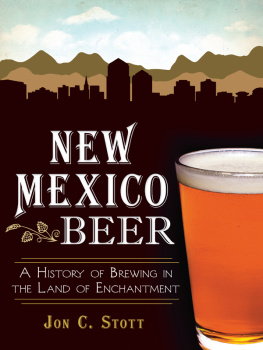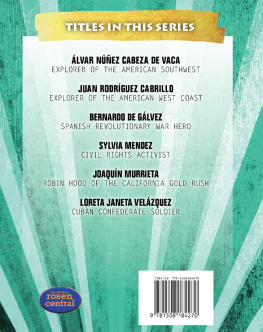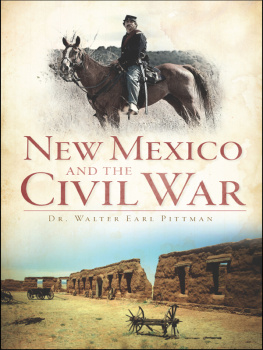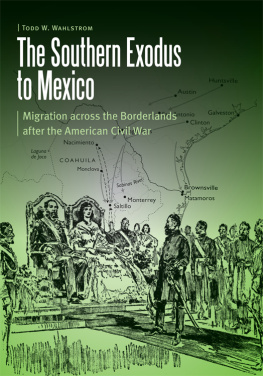African American History in New Mexico
African American History in New Mexico

Portraits from Five Hundred Years

Edited by BRUCE A. GLASRUD
2013 by the University of New Mexico Press
All rights reserved. Published 2013
Printed in the United States of America
18 17 16 15 14 13 1 2 3 4 5 6
The Library of Congress has cataloged the printed edition as follows:
African American history in New Mexico : portraits from five hundred years / edited by Bruce A. Glasrud.
p. cm.
Includes bibliographical references and index.
ISBN 978-0-8263-5301-6 (pbk. : alk. paper)ISBN 978-0-8263-5302-3 (electronic)
1. African AmericansNew MexicoHistory. 2. African AmericansNew MexicoBiography. 3. New MexicoHistory. 4. New MexicoBiography. I. Glasrud, Bruce A.
E185.93.N55A34 2013
978.90496073dc23
2012035724
Contents
Bruce A. Glasrud
David J. Weber
Dedra S. McDonald
Jim F. Heath and Frederick M. Nunn
Mark J. Stegmaier
Martin Hardwick Hall
DeAnne Blanton
Monroe L. Billington
Jeff Berg and M. A. Walton
Raymond Wilson
Horace Daniel Nash
Bruce A. Glasrud
Maisha Baton
George Long
Roger W. Banks
Richard Melzer
George M. Cooper
D. Scott Glasrud and Joshua Merrill
Preface
THIS BOOK GERMINATED from a series of conversations between myself and the editor-in-chief at the University of New Mexico Press, W. Clark Whitehorn. We both agreed that an anthology on the history of African Americans in New Mexico was long overdue and would be a key contribution to New Mexico history. After considerable research and further discussion, we reached two conclusions: first, that the project would fill a gap and should move forward, and second, that the number of published, scholarly articles on the topic of black New Mexico was limited. Therefore we turned to book excerpts and to asking a few authors to prepare original articles for the book. That process resulted in African American History in New Mexico.
The introduction, Under the Radar: Blacks in New Mexico History, provides an overview of black history and experiences in New Mexico, both chronologically and thematically, while also summarizing the selections that are included in the book. The remainder of African American History in New Mexico consists of seventeen articles on key topics of the black experience in the state. The selections cover critical aspects of those experiencesemployment opportunities, cultural contributions, black women, black soldiers, prejudice and discrimination, violence, and the creation of communities, both rural and urban. A bibliography that I prepared principally consists of secondary studiesarticles, books, dissertations, thesesof black experiences, contributions, and roles in the Land of Enchantment.
The book is intended to appeal to a broad range of readersstudents, teachers, scholars, and the general reading public. The essays represent a combination of themes and topics. They are readable, enjoyable, and packed with information. The anthology highlights and showcases the resiliency and spirit of New Mexico blacks and their communities.
I received considerable help in preparing and publishing this book. For that assistance I wish to thank a number of people. Without the scholarship and ability of the contributing authors, of course, the book would not have been feasible. The original publishers, too, must be thanked for allowing me to use their articles in this publication. Two New Mexico colleagues served as readers for the book; their effort and suggestions were followed and made it a much better collection. Thanks. W. Clark Whitehorn of the University of New Mexico Press continually provided encouragement. While conducting research at the University of New Mexico, I stayed with my nephew, D. Scott Glasrud, who agreed to write one of the chapters. His family made life enjoyable for me; and his two daughters helped me in conducting the researchthanks Amber and Ashley. Scotts son Cameron was a delight and let me beat him in basketball. I would be remiss if I did not thank George M. Cooper for writing the chapter on the modern civil rights movement. As usual, Pearlene Vestal Glasrud read and re-read the manuscript and suggested significant improvements. For the rest I remain responsible.
Bruce A. Glasrud
San Antonio, Texas
INTRODUCTION
Under the Radar
Blacks in New Mexico History
BRUCE A. GLASRUD

In late August 1908 a Texas-born black man named George McJunkin and a neighbor spotted large bison bones protruding from the bank of the Dry Cimarron River near Folsom, New Mexico. McJunkin realized their significance but it was many years before he succeeded in interesting others in his discovery. In fact, McJunkin died in 1922, four years before scientists determined that the bones were from bison estimated to be over ten thousand years old. McJunkins discovery led to the subsequent finding of human spearheads stuck among some of the bison bones. Human beings resided in the American Southwest far earlier than previously believed. The archeological site that McJunkin discovered eventually yielded human artifacts that led to knowledge about the Folsom Man. As Mary F. Germond phrased it so well, McJunkins importance rests on his recognizing the extraordinary nature of the bones and persuading people more knowledgeable than he to study them. McJunkin is one among many New Mexico African Americans who have remained under the radar of most historians and scholars.
And yet McJunkins life offered a pattern for black accomplishment on the western frontier. George McJunkin was born a slave (ca. 1851) near Rogers Prairie, on the border of Madison and Leon Counties in East Texas; his father purchased his own freedom with proceeds from his work as a blacksmith. Young McJunkin early learned to appreciate
Although a satisfactory, scholarly work about McJunkin has yet to be written, his life has been treated in publications. The most complete, though partially fictionalized, account is Franklin Folsoms The Life and Legend of George McJunkin: Black Cowboy. Two brief scholarly essays are Mary F. Germond, George McJunkin, in Dictionary of American Negro Biography, and Heather Peterson, George McJunkin, in BlackPast Online Encyclopedia












 Portraits from Five Hundred Years
Portraits from Five Hundred Years

 In late August 1908 a Texas-born black man named George McJunkin and a neighbor spotted large bison bones protruding from the bank of the Dry Cimarron River near Folsom, New Mexico. McJunkin realized their significance but it was many years before he succeeded in interesting others in his discovery. In fact, McJunkin died in 1922, four years before scientists determined that the bones were from bison estimated to be over ten thousand years old. McJunkins discovery led to the subsequent finding of human spearheads stuck among some of the bison bones. Human beings resided in the American Southwest far earlier than previously believed. The archeological site that McJunkin discovered eventually yielded human artifacts that led to knowledge about the Folsom Man. As Mary F. Germond phrased it so well, McJunkins importance rests on his recognizing the extraordinary nature of the bones and persuading people more knowledgeable than he to study them. McJunkin is one among many New Mexico African Americans who have remained under the radar of most historians and scholars.
In late August 1908 a Texas-born black man named George McJunkin and a neighbor spotted large bison bones protruding from the bank of the Dry Cimarron River near Folsom, New Mexico. McJunkin realized their significance but it was many years before he succeeded in interesting others in his discovery. In fact, McJunkin died in 1922, four years before scientists determined that the bones were from bison estimated to be over ten thousand years old. McJunkins discovery led to the subsequent finding of human spearheads stuck among some of the bison bones. Human beings resided in the American Southwest far earlier than previously believed. The archeological site that McJunkin discovered eventually yielded human artifacts that led to knowledge about the Folsom Man. As Mary F. Germond phrased it so well, McJunkins importance rests on his recognizing the extraordinary nature of the bones and persuading people more knowledgeable than he to study them. McJunkin is one among many New Mexico African Americans who have remained under the radar of most historians and scholars.